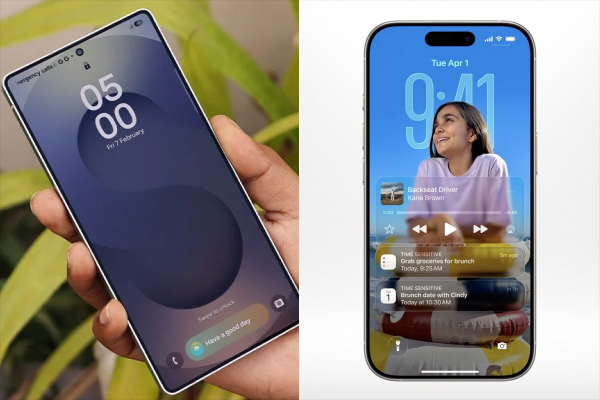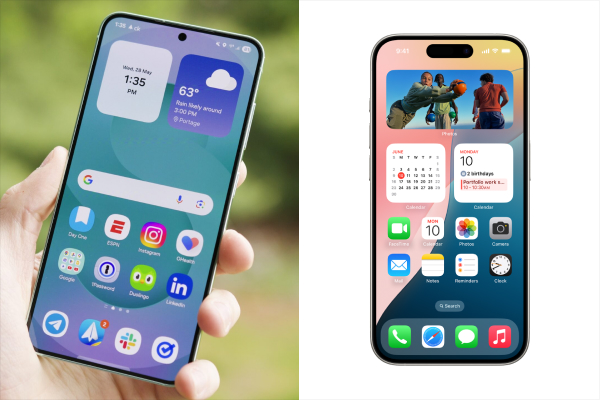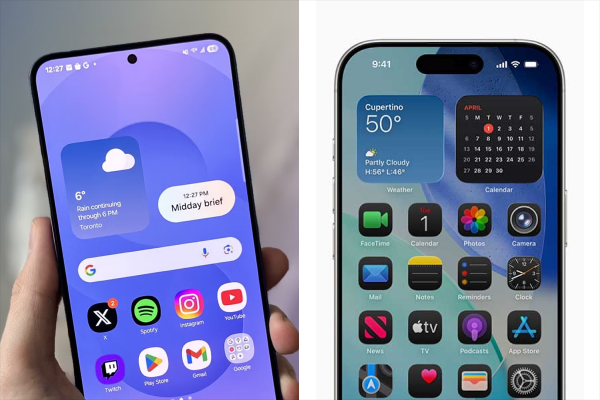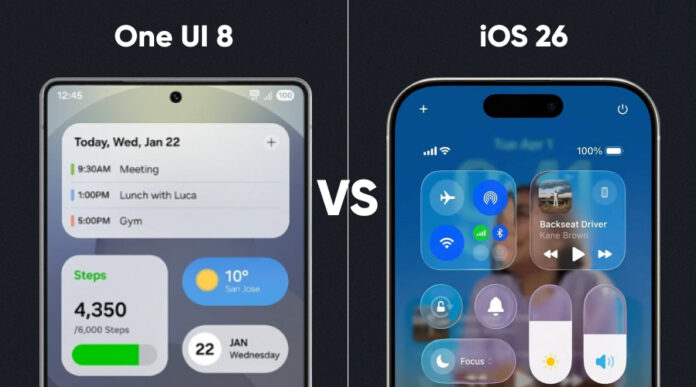Mobile technology is changing fast, and in 2025, Samsung’s One UI 8 and Apple’s iOS 26 are the most advanced mobile operating systems to ever exist. With these systems, users can work faster, customize things more, and make use of smarter artificial intelligence updates. Yet, they appeal to people with different preferences and are compatible with various platforms.
One UI 8 keeps improving Android with extra features and AI tools, whereas iOS 26 focuses on making its existing system perfectly secure and polished. Those who are deep into tech or use devices regularly should learn the differences between these two. Go through this article to learn about the main differences, what sets the two operating systems apart in features, and find out which one fits you best.
Overview of Key Differences
| Feature | One UI 8 (Samsung) | iOS 26 (Apple) |
|---|---|---|
| OS Base | Android 15 | Proprietary (based on UNIX) |
| Customization | High (Themes, Icon Packs, Layouts) | Limited (Lock screen + Widgets only) |
| AI Integration | Galaxy AI with on-device/offline features | Siri 2.0 with cloud/offline support |
| Widgets | Resizable, interactive | Interactive, Smart Stack improvements |
| Multitasking | Enhanced (pop-up view, split-screen) | Improved Stage Manager (iPad-like) |
| App Store Control | Allows third-party stores (EU-wide) | Mostly Apple-exclusive |
| Ecosystem Integration | Samsung-only, some Google integration | Seamless Apple ecosystem |
| Privacy Features | Android-based, more granular control | Apple’s strong app tracking protection |
| Update Support | 7 years (selected devices) | 6–7 years (iPhones) |
| Device Compatibility | Samsung Galaxy devices only | iPhones (iPhone 12 and above) |
One UI 8 vs. iOS 26: Comparison of Key Features
1. User Interface and Design

- One UI 8 polishes the user interface by improving animation, making icons rounded, and cleaning the layout, which is comfortable to use with one hand. It adds a superior Material You-style color system that will match your wallpaper and theme across applications. Samsung Galaxy has likewise optimized its dark mode and notification design, which presents a cohesive and smooth visual experience across devices.
- iOS 26 once again follows the minimalist design Apple has been using, but introduces minor enhancements with visual depth and animation. The transitions are more natural, and new dynamic features such as animated widgets and responsive haptics take the user experience to the next level. On the one hand, iOS does not radically reinvent its basic UI, but the refinements and responsiveness are of a premium quality.
2. Customization Options
- One UI 8 is leading in customization. There are icon packs, fonts, and home screen layouts to choose from, and even the “Samsung Good Lock” modules to modify system behavior. Themes, wallpapers, always-on displays, and gesture controls can be highly customized, and the user can really make the device their own.
- iOS 26 has restricted yet sophisticated customization. Apple has increased the lock screen choices, introduced “Focus Mode” themes, and permitted widgets to be placed on the lock screen and color filters. Nevertheless, the limitations of the home screen grid are still present, along with more extensive customizations, such as icon packs or third-party launchers, which still require breakthroughs.
3. AI and Assistant Integration
- With One UI 8, Samsung is launching an enhanced Galaxy AI with real-time translation and transcription, smart replies, summarization, and contextual understanding. Numerous AI capabilities are offline and cross-core applications, such as Notes, Messages, and Samsung Internet, which make the system experience smart and proactive to consumer needs.
- iOS 26 updates Siri to Siri 2.0, context-aware, tinier, and more integrated throughout the OS. Siri has been updated to do on-device processing, making it much quicker, and can now take app commands in a natural language. Whereas it is vastly superior, certain AI functionalities are still subject to cloud processing and are more limited in scope than what Galaxy AI is capable of.
4. Widgets and Home Screen

- One UI 8 brings fully interactive and resizable widgets that are freely placed on the screen. The user is allowed to make widgets on top of each other, change the transparency, and give them individual styles. Samsung also introduces widget stacking and intelligent suggestions, which are made according to the usage patterns.
- iOS 26 refines its Smart Stack system and enables more interactive widgets that are updated live. Although it is now possible to control smart home devices or monitor deliveries without leaving the widgets, the placement remains confined to the rigid grid system used by Apple, which does not provide much freedom of arrangement.
5. Multitasking and Productivity
- One UI 8 excels at multitasking. It adds multi-window support, pop-up display, drag and drop between apps, and a desktop-like taskbar on foldables and tablets. It allows you to pin apps to split-screen, floating windows, and context switching, which is why it is perfect for power users.
- iOS 26 makes iPads more productive with a beefier Stage Manager that allows resizing app windows and customizing workflows. But even the iPhones are yet to get split-screen multitasking, and productivity is still confined to app switching instead of being multi-window.
6. App Store and Sideloading
- One UI 8 is open to sideloading and third-party app stores, particularly in the EU, as a consequence of the Digital Markets Act. Samsung customers have more choice and control over their digital ecosystem as they are able to install applications obtained through various sources with fewer limitations.
- iOS 26 is open to offer some third-party store support in the EU, on Apple’s terms only. However, Sideloading is still limited outside of Europe. Apple has remained tight on the App Store management, with privacy and security being its major arguments.
7. Privacy and Security
- One UI 8 allows you to control permissions on a per-app basis, provides clipboard access notifications, and one-time permissions. A powerful security layer, such as Samsung Knox, should be used in business and personal use, and privacy dashboards allow keeping track of application behavior and data access.
- iOS 26 adds to its privacy package, enhanced Mail Privacy Protection, App Tracking Transparency, and secure Passkey authentication. The privacy policies of Apple continue to be among the best in the business, automatically blocking trackers and providing you with stronger control over your data.
Also see: iOS 18 Privacy Upgrade Feature for Everyone
8. Ecosystem Integration

- One UI 8 is most effective in the Samsung environment, where Galaxy Buds, Watches, and Tablets can be connected through Samsung Flow, Quick Share, and SmartThings. It also uses the Google ecosystem to enable features such as cross-device copy-paste and cloud sync, though the device transitions are not as smooth as in Apple.
- iOS 26 provides an unrivaled ecosystem synergy. Such features as Handoff, AirDrop, Universal Clipboard, and Continuity Camera are perfectly compatible with iPhones, iPads, Macs, and Apple Watches. The whole Apple ecosystem is a well-integrated system, and it enhances productivity and convenience.
9. Software Update Policy
- With One UI 8, flagship models will receive up to 7 years of software and security updates, a big leap in Android longevity. However, the pace of rollout remains dependent on the region and the phone model, with carrier-locked phones in many cases getting the update later.
- iOS 26 continues the tradition of Apple uniformity, which remains industry-leading as the majority of compatible devices are getting the update on the first day. iPhones released back in 2019 are still supported, which provides long-term support and customer happiness.
10. Performance and Battery Optimization
- One UI 8 also applies AI-enabled performance enhancement and memory optimization, which promises fluid multitasking. Battery life is also increased through adaptive charging and app sleep modes, on devices with larger batteries or custom silicon such as the Exynos or Snapdragon chips.
- iOS 26 offers a unified, fluid experience that has effective resource management. It has a close hardware-software integration, which makes the battery life optimized, even in old devices. Background processes are smartly controlled, and power-hungry activities are slowed down to ensure the long-term health of the battery.
Conclusion
In conclusion, both One UI 8 and iOS 26 are powerful and refined user experiences; however, they are suited to different users. Choose One UI 8 if you appreciate freedom, customization, and powerful multitasking. iOS 26 wins if you want stability, privacy, and a coherent ecosystem. At the end of the day, the finest OS is subjective to your demand and the gadgets that you are already accustomed to. Whether you update to Android or iOS in 2025, you are getting a stable and full-featured operating system.

